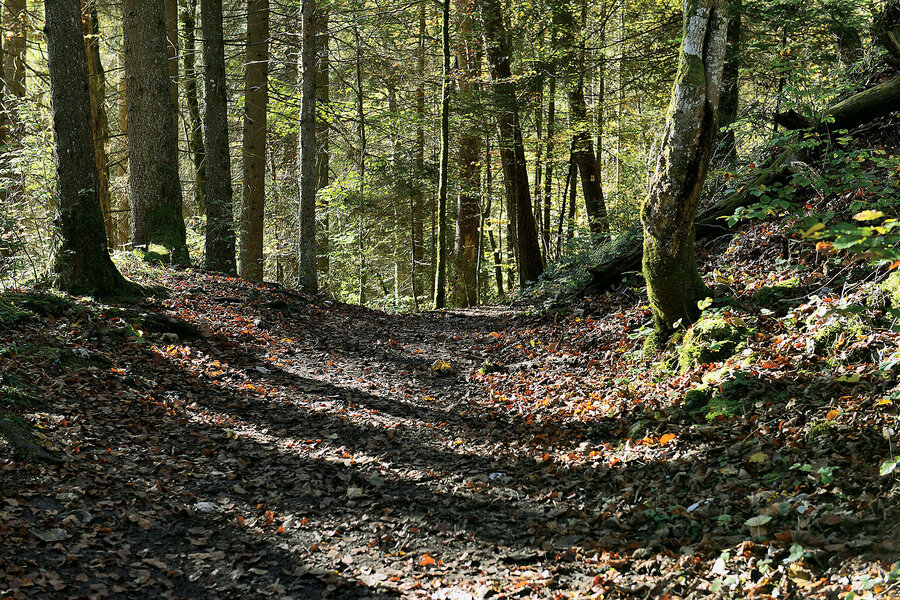‘If you want to be happy for the rest of your life,’ keep a bottomless bucket list
Loading...
I’m always up for a scavenger hunt. The pursuit is the thing: the sharpening of the senses, the possibility of discovery, the awe of seeing something wonderful for the first time, the way a child would.
So when my niece Elizabeth called to see if I wanted to help her look for a wild Brown’s peony, which is on her bucket list, I leaped at the chance.
Why We Wrote This
A story focused onAs she searched for the elusive flora and fauna on her bucket list, our writer discovered something even more valuable: Joy isn’t in the discovery – it’s in the quest.
We drove to a refuge and took off down a trail. “What do they look like?” I asked her.
“Maybe this high,” she said, her hands about a foot apart, “with glabrous and glaucous leaves.”
I looked blank.
“And the flowers, if they’re in bloom, are globose,” she finished up.
All righty then.
We tramped about a mile before Elizabeth started hooting. Not only did she see her peony, but she also gets to keep it on her bucket list, because we didn’t find one in bloom, and the blooms are neat. That means she has one more shot at glory, one more quest for joy, one more blessed ramble in a bountiful world.
If you want to be happy for the rest of your life, you never want your bucket empty.
My niece Elizabeth called the other day to see if I wanted to help her look for a wild Brown’s peony in the woods. It wasn’t exactly missing or anything, but she’d never seen one, and it was on her bucket list. Elizabeth is a botany geek.
I’m always up for a good scavenger hunt. The pursuit is the thing: the sharpening of the senses, the possibility of discovery! It’s about joy. It’s about seeing something wonderful for the very first time, the way a child would, before familiarity has a chance to rub off some of its shine. So yes, Elizabeth, count me in!
We drove to a refuge where the peonies had been reported and took off down a trail. “What do they look like?” I asked her. I thought that would be relevant information.
Why We Wrote This
A story focused onAs she searched for the elusive flora and fauna on her bucket list, our writer discovered something even more valuable: Joy isn’t in the discovery – it’s in the quest.
“Maybe this high,” she said, her hands about a foot apart, “with glabrous and glaucous leaves.”
I looked blank.
“And the flowers, if they’re in bloom, are globose,” she finished up.
All righty then. I still had a chance to trip over her prized peony through sheer serendipity, which is a frequent companion of mine, and I’m always up for a hike. We tramped about a mile before Elizabeth started hooting. The peony had been spotted! Well, not spotted per se, but definitely glabrous and glaucous. After that first one, dozens more were seen. By Elizabeth.
Meanwhile, I had my own bucket to fill and binoculars to fill it with, because I like birds. That’s what birding is all about – that same delicious anticipation of joy. Because nobody’s seen all the birds, and they’re all worth seeing. We keep our antennae up for silhouettes in the sky and skittering in the brush, and around any corner on any given day we might find one we’ve never seen before: a “Life Bird”!
Maybe the pursuit of life birds is a competitive endeavor for some people, but my bad eyesight and utter lack of skill save me from all that. My list of life birds is short. That’s OK: I figure I have that much more to look forward to.
Elizabeth and I took a break from the peonies to admire a wet meadow where, according to the bird ID app on my phone, a sora was hanging out. I know what soras are supposed to look like – they’re sort of globose, if you must know – but I was unable to locate the bird in question. Which is a pity, because I could have added it to my life list.
But maybe not for the first time. That’s the other reason my list is so short. My capacity for forgetting is legendary. No sooner do I put a bird on my life list than it hops out. There’s almost no limit to the number of times I can see any given bird for the first time.
Case in point: my first look at an ovenbird. An orange-crowned, speckled little wonder of a warbler he was, strutting importantly around the forest floor like some real estate mogul! My friends identified him for me three or four more times that morning; they pointed out his field marks; they remarked on his peculiar habit of walking through the woods.
Same day, hours later, I locked onto a terrific little speckled number sauntering through the duff. “Ooh! What’s that one?” I chirped. They stared at me.
“That’s still an ovenbird,” they said.
Seeing my very first ovenbird, in all his tiny majesty, was an absolute thrill. All six times.
I’m not sure I will recognize a Brown’s peony if I ever see another one, either. But Elizabeth was happy. Not only did she see her target plant, but she also gets to keep it on her bucket list, because we didn’t find one in bloom, and the blooms are neat. The blooming peony means she has one more shot at glory, one more quest for joy, one more blessed ramble in a bountiful world. If you want to be happy for the rest of your life, you never want your bucket all the way empty.
Of course, it works just as well if your bucket is leaky.








